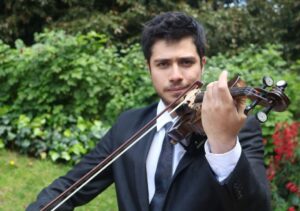|
David Cadena Violin Colombian Age: 27 Ludwig van Beethoven Ernest Bloch |
David is a violinist, currently undertaking a Masters in Classical String Performance with Professor André Swanepoel at the Irish World Academy in Limerick. Originally from Colombia, he started studying violin at the age of 7 at the Youth Symphony Orchestra Foundation of Colombia. His keen interest only grew over time. At the age of 20 he began studying his Bachelor’s degree in music with Professor Miguel Garcia (violin performance) at University of Cundinamarca. During this time, David discovered his love for chamber music, where he felt the creative expression of the musicians could be developed, finding nuances within interpretation of the sheet music. Since then, David has been involved in many string quartet performances. These encompassed classical repertoire as well as innovative adaptations of various music styles. Beyond classical music, David´s interests also include rock music, South American folk music, and Traditional Irish music.
His music practice has been enriched by participating in academic music festivals across Latin America; (FEMUSC) Music Festival in Santa Catarina, Brazil and (FIMG), Music Festival in Guadalajara, Mexico. He has taken classes with teachers such as: Luis Martín Niño (Colombia), Robert Stepanian (Armenia), Mikhail Zemtzov (Russia), Alessandro Borgomanero (Brazil), and Erika Dobosiewicz (Poland), Carolin Widmann (Germany). These experiences have shaped David´s violin practice. In the future, David aspires to participate in further chamber music projects as well as in orchestras. |
| Programme Notes
The Ludwig van Beethoven piece is a captivating three-movement work for violin and piano composed in 1801.Presto: The first movement is marked Presto, which means it’s played at a brisk tempo. Beethoven’s characteristic energy and drama are evident here. Ernest Bloch’s three-movement Baal Shem: Three Pictures of Hassidic Life, for violin and orchestra or violin and piano, one of his best-known works, is named after the acknowledged 18th-century founder of the Hassidic movement, Rabbi Israel ben Eliezer (1700–60). The second movement, Nigun [Heb., niggun; Yiddish, nign), is the most familiar of all three and is sometimes programmed on its own. Its title refers in a general way to the emotional power and mystical fervour of Hassidic song, although the nigun, admittedly the most common Hassidic musical association, is only one of the Hassidic song forms or types. The Hebrew niggun (along, originally, with its Yiddish derivative, nign) is a generic term simply meaning “melody” or “tune.” |
|
- Registration Form
- Final Details and Agreement Submission
- Semi-final Programme Details (18-20 mins)
- Welcome to the registration page for the Irish Freemasons Young Musician of the Year Competition.
- Final Programme Details (25-30 mins)
- Course and College/University Details
- Many thanks for submitting your application.

